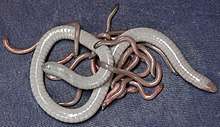Herpelidae
Herpelidae are a family of caecilians, sometimes known as the African caecilians. They are found in Sub-Saharan Africa.[1][2][3] Like other caecilians, they superficially resemble worms or snakes.[3] They are the sister group to the newly discovered Chikilidae.[4]
| Herpelidae | |
|---|---|
 | |
| Female Herpele squalostoma with her young | |
| Scientific classification | |
| Kingdom: | Animalia |
| Phylum: | Chordata |
| Class: | Amphibia |
| Order: | Gymnophiona |
| Clade: | Apoda |
| Family: | Herpelidae Laurent, 1984 |
| Type genus | |
| Herpele Peters, 1875 | |
| Genera | |
Distribution
Herpelidae occur primarily in Central and East Africa, barely reaching West Africa (southeastern Nigeria), and northern parts of Southern Africa (Malawi, possibly Zambia).[1]
Genera
There are two genera with ten species in total:[1][2]
- Boulengerula Tornier, 1896 – Boulenger's caecilians, Usambara bluish-gray caecilians (8 species)
- Herpele Peters, 1880 – Congo caecilians (2 species)
gollark: ++delete H
gollark: ++delete ☭
gollark: ++delete gibson's death
gollark: Really? Oh dear.
gollark: No, I'm the antidisestablishmentarianism.
References
- Frost, Darrel R. (2018). "Herpelidae Laurent, 1984". Amphibian Species of the World: an Online Reference. Version 6.0. American Museum of Natural History. Retrieved 22 May 2018.
- "Herpelidae". AmphibiaWeb. University of California, Berkeley. 2018. Retrieved 22 May 2018.
- Vitt, Laurie J. & Caldwell, Janalee P. (2014). Herpetology: An Introductory Biology of Amphibians and Reptiles (4th ed.). Academic Press. pp. 451–452.
- Frost, Darrel R. (2018). "Chikilidae Kamei, San Mauro, Gower, Van Bocxlaer, Sherratt, Thomas, Babu, Bossuyt, Wilkinson, and Biju, 2012". Amphibian Species of the World: an Online Reference. Version 6.0. American Museum of Natural History. Retrieved 22 May 2018.
This article is issued from Wikipedia. The text is licensed under Creative Commons - Attribution - Sharealike. Additional terms may apply for the media files.